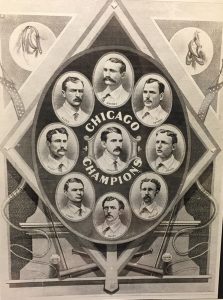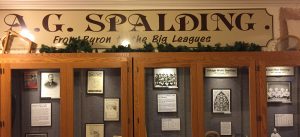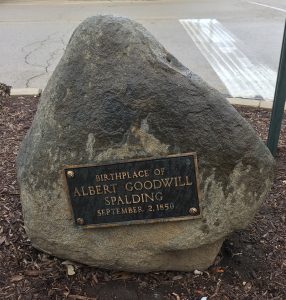Small town Byron’s big league baseball claim to fame
By Jack McCarthy Chronicle Media — April 6, 2017

Among AG Spalding artifacts at the Byron Museum of History is a copy of a photo of Spalding’s Chicago White Stockings champions. Spaling is in the center. (Photo by Jack McCarthy)
In tiny Byron, favorite son Albert Goodwill Spalding is sometimes credited as the “Father of Baseball.”
The truth is more complicated in a sport that traces its origins to the early 1800s and a consensus — supported by Spalding himself — that Abner Doubleday created the game in 1839.
But Spalding, born in a Byron log cabin in 1850, is unquestionably a consequential figure in the game.
Baseball began its 141st professional season this week with an organizational structure and the style of today’s game that can be traced to Spalding’s era. Further, his one-time organization — the Chicago Cubs — were back atop the baseball world as defending World Series champs.
No matter the origin story, the sports-minded Ogle County community celebrates the history and legacy of Spalding with a permanent exhibit at the Byron Museum of History and several other locations around the town of 3,686.
“He had three careers – as a baseball pitcher, a club owner, and a sporting-goods tycoon – and was very successful at all of them,” wrote Bill McMahon of the Society for American Baseball Research.
The museum exhibit features replica baseball uniforms from Spalding’s era as well as other artifacts, period baseball lore and news clippings from Spalding’s life and career.
Spalding learned about the sport through returning Civil War veterans who played versions of baseball while serving. He proceeded to take up the game and discovering he was quite good at it, according to a Byron museum account.
Among teams he played for were the Rockford Forest Citys, an early pro team.
“Byron was kind of a good farm for the professional teams because not only Spalding but a few of his teammates went up to the majors,” said Dan Wykes, Byron Museum of History educator.
And when the first professional baseball association was formed in 1871, Spalding began a five-year career with the Boston Red Stockings.
“He was then lured back to Chicago and became a player-manager,” Wykes said.
Spalding joined the Chicago White Stockings — the precursor team to the Chicago Cubs — for two seasons. He helped manage and was the lone pitcher as they won the first National League pennant in 1876.
Spalding ended his playing career after that season, switching to a management role first as White Stockings secretary and as president by 1882 as the team went on to win five National League pennants between 1860-66.

A display case of Albert Goodwill Spalding memorabilia at the Byron Museum of History in Ogle County. (Photo by Jack McCarthy)
He also joined his brother in starting the Spalding Brothers Sporting Goods Co., which started manufacturing baseballs for professional teams and eventually expanded into other sports.
“There was a need for a consistent ball that would be in play at all the venues,” Wykes said. “He started the Spalding Baseball Manufacturing Company to make the balls and then he donated those balls to the league. Of course, he wasn’t stupid because they (the teams) also bought bats and gloves.”
The company is now a division of Russell Company, which acquired the brand in 2003.
Spalding was inducted into the Baseball Hall of fame in 1939. He died in 1915.
Along with the Spalding, the Byron museum displays a variety of exhibits focusing on local and area history.
Other sports are saluted, including the community’s early inclusion of girls in athletic competition. Byron today boasts recent girls state championship track teams (2009-10 and 2010-11) as well as two-time reigning girls basketball state champs.
The museum is also noted nationally as a site on the 19th Century Underground Railroad that provided safe haven for escaped slaves being smuggled into northern states and Canada.
The Read House, the original museum building, was owned by abolitionists and is a popular stop for school tour groups. It is accompanied by a photographs and stories about the building’s original residents including a tour of the basement where escaped slaves sometimes were hidden.

A downtown plaque notes the community as the birthplace of AG Spalding. (Photo by Jack McCarthy / Chronicle Media)
The museum also has exhibits on the city’s rail history — including a working scale model of the community in the early 1900s and a 1910 model railroad that runs through town at the push of a button.
Other exhibits include a look back at the community’s businesses from 1935-1975, local residents who served in the military over the decades and a peek back at old time farming.
Prior to indoor plumbing, outhouse toilets were used by residents for their personal needs but also as a dumping spot for household trash. A museum exhibit has unearthed and displays its findings from onetime disposal sites.
Admission is free. The museum, located at 110 N. Union St., is open from 10 a.m.-3 p.m. Wednesday-Saturday with more limited winter hours.
— Small town Byron’s big league baseball claim to fame —



